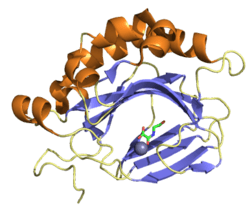ASPH
Aspartyl/asparaginyl beta-hydroxylase (HAAH) is an enzyme that in humans is encoded by the ASPH gene.[1][2][3]
Function
This gene is thought to play an important role in calcium homeostasis. Alternative splicing of this gene results in five transcript variants which vary in protein translation, the coding of catalytic domains, and tissue expression. Variation among these transcripts impacts their functions which involve roles in the calcium storage and release process in the endoplasmic and sarcoplasmic reticulum as well as hydroxylation of aspartic acid and asparagine in epidermal growth factor-like domains of various proteins.[3]
Clinical significance
As early as 1996, the over-expression of HAAH was recognized as an indicator of carcinoma in humans. Further research has correlated elevated HAAH levels (variously in affected tissue or blood serum) with hepatocellular (liver) carcinoma[4][5] adenocarcinoma (pancreatic cancer),[6] colorectal cancer,[7] prostate cancer.[5] and lung cancer.[8] The pancreatic study[6] showed elevated HAAH only in diseased tissue, but not in adjacent normal and inflamed tissue.
Mutations in ASPH cause Traboulsi syndrome .Patel, N; Khan, A. O.; Mansour, A; Mohamed, J. Y.; Al-Assiri, A; Haddad, R; Jia, X; Xiong, Y; Mégarbané, A; Traboulsi, E. I.; Alkuraya, F. S. (2014). "Mutations in ASPH Cause Facial Dysmorphism, Lens Dislocation, Anterior-Segment Abnormalities, and Spontaneous Filtering Blebs, or Traboulsi Syndrome". The American Journal of Human Genetics 94 (5): 755–9. doi:10.1016/j.ajhg.2014.04.002. PMID 24768550.
References
- ↑ Korioth F, Gieffers C, Frey J (Feb 1995). "Cloning and characterization of the human gene encoding aspartyl beta-hydroxylase". Gene 150 (2): 395–9. doi:10.1016/0378-1119(94)90460-X. PMID 7821814.
- ↑ Lim KY, Hong CS, Kim DH (Nov 2000). "cDNA cloning and characterization of human cardiac junctin". Gene 255 (1): 35–42. doi:10.1016/S0378-1119(00)00299-7. PMID 10974562.
- 1 2 "Entrez Gene: ASPH aspartate beta-hydroxylase".
- ↑ Ince N, de la Monte SM, Wands JR (March 2000). "Overexpression of human aspartyl (asparaginyl) beta-hydroxylase is associated with malignant transformation". Cancer Res. 60 (5): 1261–6. PMID 10728685.
- 1 2 Xue T, Xue XP, Huang QS, Wei L, Sun K, Xue T (August 2009). "Monoclonal antibodies against human aspartyl (asparaginyl) beta-hydroxylase developed by DNA immunization". Hybridoma (Larchmt) 28 (4): 251–7. doi:10.1089/hyb.2009.0017. PMID 19663697.
- 1 2 Palumbo KS, Wands JR, Safran H, King T, Carlson RI, de la Monte SM (July 2002). "Human aspartyl (asparaginyl) beta-hydroxylase monoclonal antibodies: potential biomarkers for pancreatic carcinoma". Pancreas 25 (1): 39–44. doi:10.1097/00006676-200207000-00010. PMID 12131769.
- ↑ "CC Detect - Serum-Based Diagnostic Test For Colon Cancer Available".
- ↑ Hampton T (November 2007). "New screening techniques show potential for early detection of lung cancer". JAMA 298 (17): 1997. doi:10.1001/jama.298.17.1997. PMID 17986689.
Further reading
- Hirota K, Semenza GL (2005). "Regulation of hypoxia-inducible factor 1 by prolyl and asparaginyl hydroxylases". Biochem. Biophys. Res. Commun. 338 (1): 610–6. doi:10.1016/j.bbrc.2005.08.193. PMID 16154531.
- Lavaissiere L, Jia S, Nishiyama M; et al. (1996). "Overexpression of human aspartyl(asparaginyl)beta-hydroxylase in hepatocellular carcinoma and cholangiocarcinoma". J. Clin. Invest. 98 (6): 1313–23. doi:10.1172/JCI118918. PMC 507557. PMID 8823296.
- Zhang L, Kelley J, Schmeisser G; et al. (1997). "Complex formation between junctin, triadin, calsequestrin, and the ryanodine receptor. Proteins of the cardiac junctional sarcoplasmic reticulum membrane". J. Biol. Chem. 272 (37): 23389–97. doi:10.1074/jbc.272.37.23389. PMID 9287354.
- Wetzel GT, Ding S, Chen F (2000). "Molecular cloning of junctin from human and developing rabbit heart". Mol. Genet. Metab. 69 (3): 252–8. doi:10.1006/mgme.2000.2966. PMID 10767180.
- Dinchuk JE, Henderson NL, Burn TC; et al. (2001). "Aspartyl beta -hydroxylase (Asph) and an evolutionarily conserved isoform of Asph missing the catalytic domain share exons with junctin". J. Biol. Chem. 275 (50): 39543–54. doi:10.1074/jbc.M006753200. PMID 10956665.
- Treves S, Feriotto G, Moccagatta L; et al. (2001). "Molecular cloning, expression, functional characterization, chromosomal localization, and gene structure of junctate, a novel integral calcium binding protein of sarco(endo)plasmic reticulum membrane". J. Biol. Chem. 275 (50): 39555–68. doi:10.1074/jbc.M005473200. PMID 11007777.
- Kirchhefer U, Neumann J, Baba HA; et al. (2001). "Cardiac hypertrophy and impaired relaxation in transgenic mice overexpressing triadin 1". J. Biol. Chem. 276 (6): 4142–9. doi:10.1074/jbc.M006443200. PMID 11069905.
- Sepe PS, Lahousse SA, Gemelli B; et al. (2002). "Role of the aspartyl-asparaginyl-beta-hydroxylase gene in neuroblastoma cell motility". Lab. Invest. 82 (7): 881–91. doi:10.1097/01.lab.0000020406.91689.7f. PMID 12118090.
- Ho SP, Scully MS, Krauthauser CM; et al. (2002). "Antisense oligonucleotides selectively regulate aspartyl beta-hydroxylase and its truncated protein isoform in vitro but distribute poorly into A549 tumors in vivo". J. Pharmacol. Exp. Ther. 302 (2): 795–803. doi:10.1124/jpet.302.2.795. PMID 12130746.
- Strausberg RL, Feingold EA, Grouse LH; et al. (2003). "Generation and initial analysis of more than 15,000 full-length human and mouse cDNA sequences". Proc. Natl. Acad. Sci. U.S.A. 99 (26): 16899–903. doi:10.1073/pnas.242603899. PMC 139241. PMID 12477932.
- Maeda T, Sepe P, Lahousse S; et al. (2004). "Antisense oligodeoxynucleotides directed against aspartyl (asparaginyl) beta-hydroxylase suppress migration of cholangiocarcinoma cells". J. Hepatol. 38 (5): 615–22. doi:10.1016/S0168-8278(03)00052-7. PMID 12713872.
- Treves S, Franzini-Armstrong C, Moccagatta L; et al. (2004). "Junctate is a key element in calcium entry induced by activation of InsP3 receptors and/or calcium store depletion". J. Cell Biol. 166 (4): 537–48. doi:10.1083/jcb.200404079. PMC 1868564. PMID 15302852.
- Beausoleil SA, Jedrychowski M, Schwartz D; et al. (2004). "Large-scale characterization of HeLa cell nuclear phosphoproteins". Proc. Natl. Acad. Sci. U.S.A. 101 (33): 12130–5. doi:10.1073/pnas.0404720101. PMC 514446. PMID 15302935.
- Xian ZH, Zhang SH, Cong WM; et al. (2006). "Expression of aspartyl beta-hydroxylase and its clinicopathological significance in hepatocellular carcinoma". Mod. Pathol. 19 (2): 280–6. doi:10.1038/modpathol.3800530. PMID 16341145.
- de la Monte SM, Tamaki S, Cantarini MC; et al. (2006). "Aspartyl-(asparaginyl)-beta-hydroxylase regulates hepatocellular carcinoma invasiveness". J. Hepatol. 44 (5): 971–83. doi:10.1016/j.jhep.2006.01.038. PMID 16564107.
- Feldmann G, Nattermann J, Nischalke HD; et al. (2006). "Detection of human aspartyl (asparaginyl) beta-hydroxylase and homeobox B7 mRNA in brush cytology specimens from patients with bile duct cancer". Endoscopy 38 (6): 604–9. doi:10.1055/s-2006-925065. PMID 16673309.
- Gundogan F, Elwood G, Greco D; et al. (2007). "Role of aspartyl-(asparaginyl) beta-hydroxylase in placental implantation: Relevance to early pregnancy loss". Hum. Pathol. 38 (1): 50–9. doi:10.1016/j.humpath.2006.06.005. PMID 16949909.
| ||||||||||||||||||||||||||||||||||
| ||||||||||||||||||



